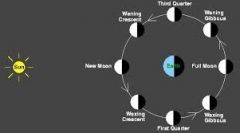![]()
![]()
![]()
Use LEFT and RIGHT arrow keys to navigate between flashcards;
Use UP and DOWN arrow keys to flip the card;
H to show hint;
A reads text to speech;
32 Cards in this Set
- Front
- Back
|
Whats the difference between rotation and revolution? |
Rotation is the spinning on an axis Revolution is the movement of an object around another. Like during an orbit |
|
|
What is the orbital(revolution) period of Earth? |
365.25 days |
|
|
Why is the orbital(revolution) period of Earth significant to calendar markers? |
Because the revolution time is 365.25 days, we add 1 day every 4 years to keep special dates on the same day |
|
|
Why does Earth have seasons? |
Earth has seasons because of the Earth's orbit and tilt of Earth's axis global temperatures vary as the position of the sun changes throughout the year |
|
|
What does the sun's angle of insolation have to do with temperature? |
the suns angle of insolation(angle of sun rays) strike the earth's surface as the angle increases, temperature increases |
|
|
What is the significance of March 20/21 in the northern hemisphere? |
March 20/21 is the spring equinox marks the beginning of spring ❁ |
|
|
What is the significance of March 20/21 in the southern hemisphere? |
Beginning of Autumn in the southern hemisphere |
|
|
What is the significance of June 20/21 in the northern hemisphere? |
Summer solstice marks the beginning of summer |
|
|
What is the significance of June 20/21 in the southern hemisphere? |
Beginning of winter in the southern hemisphere |
|
|
What is the significance of September 22/23 in the Northern hemisphere? |
September 22/23 in the northern hemisphere is the beginning of autumn the autumn equinox |
|
|
What is the significance of September 22/23 in the Southern hemisphere? |
september 22/23 in the southern hemisphere is the beginning of spring |
|
|
What is the significance of December 20/21 in the Northern hemisphere? |
December 20/21is the winter solstice and the beginning of winter |
|
|
What is the significance of December 20/21 in the Southern hemisphere? |
its the beginning of Summer |
|
|
How does the earth's tilt affect the length of days? |
the tilt causes daylight to be shorter in winter and longer in summer |
|
|
What is the significance of the Article circle and the Antarctic circle as they relate to the length of daylight during the year? |
they get 24 hours of dark and 24 hours of light at opposite times during the solstices |
|
|
What is the lunar cycle? |
the time need for the moon to return to the same place in the sky (29.5 days) |
|
|
Why do we say that the moon has a "synchronous" rotation? |
The moon has a synchronous rotation because it is in synch with earth's orbit. meaning the same side always faces earth |
|
|
What are the moon's phases? |
the different shadow effects on the moon as seen from earth |
|
|
What are the phases of the moon and what do they look like? |
🌑 new moon |
|
|
Know where the earth goes in each position |

|
|
|
In which direction does the light and shadow advance across the face of the moon? |
the sunlight moves from right to left across the face of the moon |
|
|
During which phases of the moon do solar and lunar eclipses occur? |
Lunar and solar eclipses occur during a full moon or new moon |
|
|
What is the difference between a partial and total eclipse? |
A partial eclipse is when a specific part of earth is in the penumbra so there is not total darkness A total eclipse is when a specific part of the earth is in the umbra meaning there is total darkness |
|
|
What causes tidal changes? |
The gravitational pull of the moon in earths orbit causes tides |
|
|
What is the importance of knowing daily tidal changes? |
it is what tells us about the interaction between earth and the moon and the moon's position |
|
|
How does the moon compare to the Earth? |
• The moon is 1/4 the size of the earth • Moons gravitational force is 1/6 that of earth • the moon was once geologically active
|
|
|
What is the surface temperature and weather on the moon? |
• 215*F •No atmosphere= no weather phenomena |
|
|
What features can be found on the moons surface? |
•Maria • Highlands • Mountain Ranges • Rilles • Regolith(lunar soil) |
|
|
What do scientists know about the moons internal composition? |
The moon has ice under the surface and used to have volcanic lava flows. was once geologically active |
|
|
Does the moon have an atmosphere? Why is this important to humans inhabiting the moon? |
Nope! Without an atmosphere, humans cannot live there |
|
|
How did the moon form? |
Thought to be formed as a result of collision of 2 large objects (asteroid) with earth |
|
|
When did the moon form? |
4.5-4.7 billion years ago |

